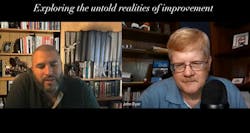Podcast: Decoding Tribal Language: Leadership Strategies for a Collaborative Culture
Which employees feel like victims and why? Which employees are self-promoters, anxious to boost their own interests? And which employees are all in on working on teams? Each of these employee groups has a language of its own, and if you are stepping in to lead a change effort within an organization, it’s important to understand and respond to these language dynamics.
In this episode of Behind the Curtain: Adventures in Continuous Improvement, podcast co-hosts Mohamed Saleh and John Dyer discuss how employee language reflects an organization’s culture and share leadership strategies to break down silos, choose change agents and develop a team-based collaborate culture.
Saleh leads the discussion by outlining four types of “tribes” within organizations, and he references the book Tribal Leadership: Leveraging Natural Groups to Build a Thriving Organization as a valuable resource.
The four types include victim (two types), the self-promoter and the team-based. The most dangerous of these types is the self-promoter. Everything they do is “not to help the company, but to build their own resume, to build their own legacy,” he says. The language of this group is “I.”
The fourth type is the aim of a collaborative culture: team-based. “They use the word “we” a lot. We could do this. We are able to do that,” Saleh says.
What strategies help break down these silos and encourage collaboration? Saleh and Dyer discuss:
- Form “triad” teams and consider informal leaders to model desired behaviors.
- Choose change agents carefully, as selecting a self-promoter may unintentionally lead to reinforcing undesirable behaviors.
- Provide consistent leadership communication. “… and make sure that you have different vehicles that speak to different types of tribes,” Saleh says.
